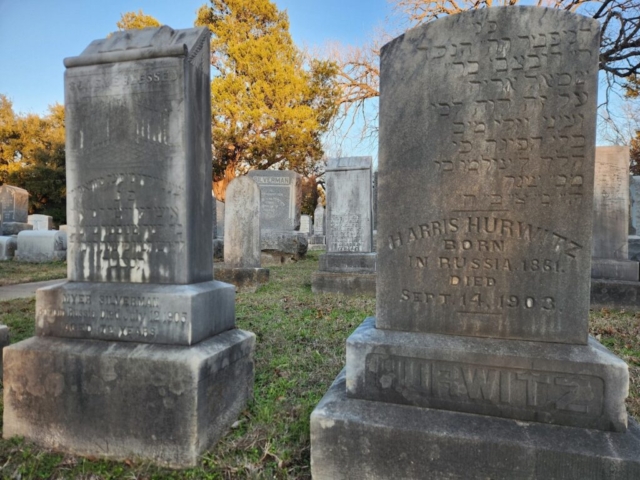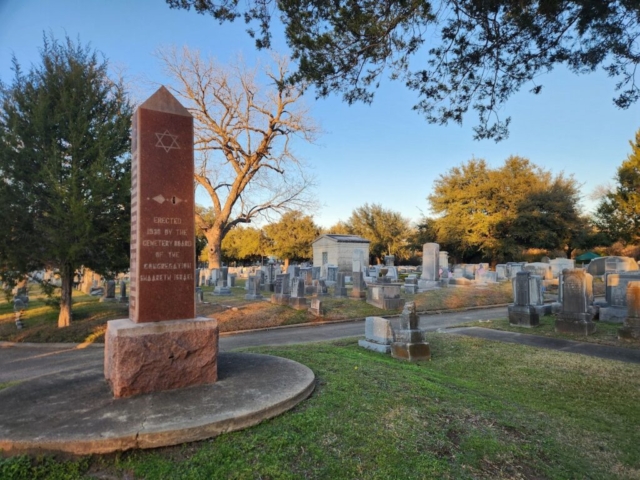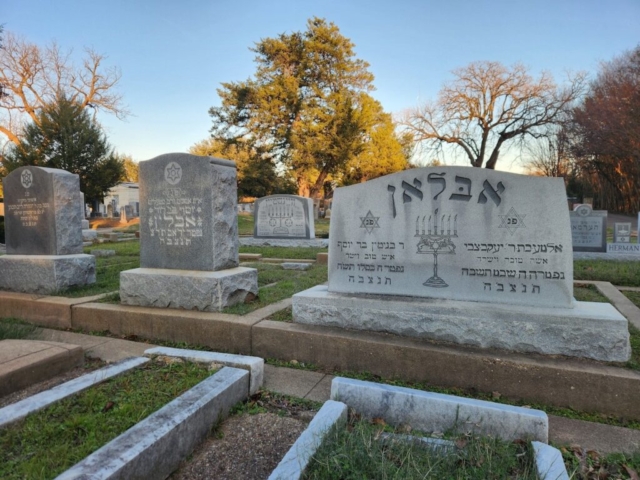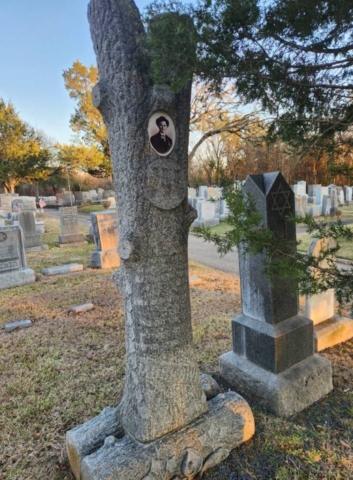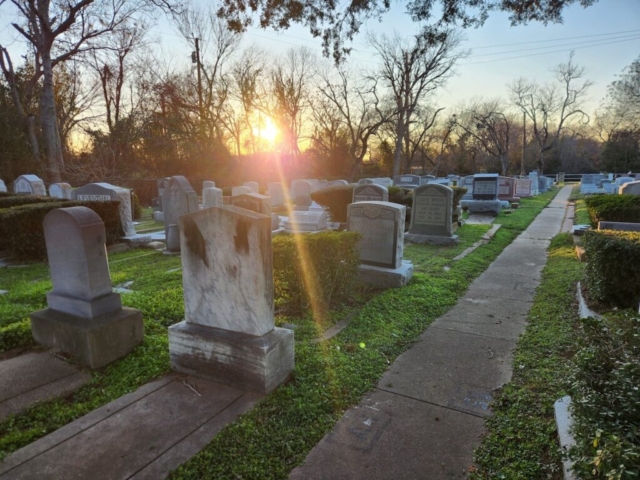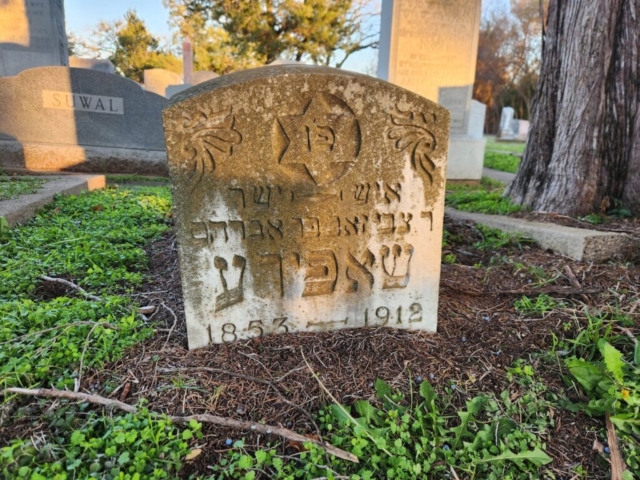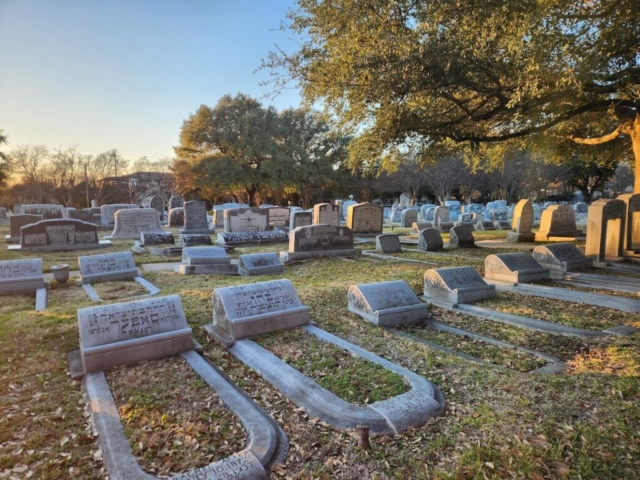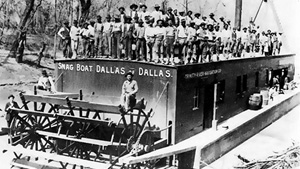
By Frances James (1922 – 2019)
On the east side of the 4600 Block of Dolphin Road is the Orthodox Jewish Cemetery now known as Shearith Israel. The cemetery is a combination of three individual cemeteries, the Tefereth Israel, the Roumanian/Austrian Benevolent Association, and Congregation Shaareth Israel, all started at this site. This location was selected in the 1880s when many of the first Jewish families coming to Dallas County lived south of downtown Dallas. The first burial at this site was Max Pollock in 1881. Some death certificates at the turn of the century called this site the White Rock Cemetery probably because White Rock Creek is near the east side of the cemetery.
The site is a portion of the nearly 4400 acres of land in Dallas County that was in the Lagow League. Thomas Lagow had been given a “League and Labor of land” by the Republic of Texas for his assistance with the War with Mexico in the 1830s. A labor is used to express the area of land that is equal to about 177.1 acres. It was used in the archaic system of old Spanish land grants affecting Texas and parts of adjoining states. The labor is often used as an approximate equivalent to a quarter-section (that is, one quarter of a square mile of land). A league is used to express the area of land. A (square) league is equivalent to about 4,428.4 acres. A common Texas land grant size, discussed in James Michener’s Texas, was a “labor and a league”: one labor of good riparian land, and a (square) league of land away from the river.
John Beeman had purchased a section of land, 640 acres, from Thomas Lagow when the Beemans came to Dallas after spending several months in 1843 helping erect Bird’s Fort in what is now Tarrant County.
Shearith Israel Cemetery [the current name] is adjacent to the Beeman Cemetery which began with the death of John Beeman in 1856. John has been quoted as saying, “This is the prettiest place on the farm.” The Beeman block house, built in 1843, was across Dolphin Road on land to the west that is now vacant.
There is scant knowledge of the first Jewish person to come to the Three Forks of the Trinity area. In the book by Rose Biderman, “They Came To Stay” a wonderful story of Jews of Dallas 1870-1997, her research found one Jew in Dallas in 1858. Alec Simon, native of Poland, who advertised in the Dallas Herald that the goods in his general store were “cheaper than the cheapest.” In the history that was compiled by members of the First Methodist Church in Garland organized in 1855, the Reverend I. S. Ashburn describes a protracted meeting held under a brush arbor. Rev. Ashburn tells of the missionary collection and their finding of a $5.00 bill! This large donation was attributed to “one of the Levy brothers, a Dallas Jew.” No other information on who this might have been is available.
Rose Biderman describes the life of these Jewish pioneers when they started arriving in Dallas. In many cases they were young single men who came first and stayed in boarding houses or rented a room at a hotel. After the small stores and shops or itinerant businesses were established in or near the small village of Dallas the men moved to other living quarters and sent for their loved ones. A community to the north of downtown Dallas with some housing available soon formed in the area that later became known as “Little Mexico.” When the Jews were able to move to other neighborhoods the Mexican immigrants moved into their vacant housing.
These first Jewish families that came to Dallas were predominately escaping from Germany and Russia and could not speak English. They managed to settle near other people who spoke their language and helped each other. By 1872 there were about 2000 people in Dallas and probably less than one tenth were of the Jewish faith. The first known burial was of a young man in June 1872. He was buried by the Dallas Hebrew Benevolent Association on land they acquired from the city, next to the Masonic and Odd Fellow Cemetery in downtown Dallas.
The first Jewish Congregation in Dallas, Temple Emanu El, which means “God With Us” had been formed with about forty families in 1872 as a liberal congregation. The Orthodox or traditional minded Jews attended worship services with them. By 1884 as the population of Dallas expanded after the railroads arrived making Dallas a crossroads community, there were enough Jews that wanted to worship in the more traditional manner to form an Orthodox congregation.
Shaareth Israel, which means “Remnant of Israel,” was organized with twenty families. A Torah was procured and they met upstairs over Bradford’s Grocery on Elm at Akard. As more space was needed, two available structures, Turner Hall or Phoenix Hall, were used for services for several years. In 1892, through the efforts of Charles Goldstein, this small group was finally able to build a three story synagogue near what is now the Farmer’s Market on Jackson Street.
There is a plaque on the small building in the cemetery property that denotes it was in honor of Charles Goldstein the founder of Shaareth Israel in 1892. Russian native Mr. Goldstein, a Main Street pawnbroker went back to Russia in 1881. An article in the Daily Times Herald newspaper described his visit. He was armed with a passport from the secretary of state but was seized by the Russian police and jailed. The article tells that he finally escaped due to the efforts of the American consul and lost no time getting back to “God’s country!” Russia was severely harassing the Jewish citizens at that time by opening all mail from their American countrymen and the Rabbis were subject to arrest and prosecution if they even received any mail.
Mr. Goldstein served as president of the Shaarath Israel congregation for four years. He then went to the Klondike gold fields. When he died in 1904 and his will was read, he had left a bequest to Shaareth Israel for all the debts to be paid, even before other bequests were granted.
On the western side of the site is a special section dedicated to the children. A small sign says that donations for the care of this plot will be accepted.
At one time each of these congregations had their own section of the Shaareth Israel Cemetery with their own set of rules. A sign on the fence facing Dolphin Road says Tiferet Israel along the space that was once owned by them. There are several historical markers within the cemetery that include the names of those who participated in the founding of the individual congregations or their cemetery. These help explain the various sections. One marker explains the portion that was the original cemetery in 1906 that was the Anshe Sphard Congregation and lists the founders.
There is a memorial to the veterans who lost their lives in World War I and II. Near this site is a ground level marker that explains the burial of Holy Books and sacred religious articles of Congregation Shearith Israel that because of wear and tear could no longer be utilized for worship.
In 1890 Congregation Tiferet Israel had been founded to accommodate the Orthodox Jews who lived on the north side of the town of Dallas. It was close enough they could walk to the services held on Highland Street. A group of members became dissatisfied with the ritual in 1906 and organized the Roumanian/Austrian Benevolent Association which later became the first Roumanian/Austrian Congregation. This group was known as Congregation Anshe Sphard. They purchased a portion of the Shaareth Israel Cemetery in 1909 for their congregation, but on their Golden Anniversary sold it back to Shearith Israel and the two congregations merged.
As the different Rabbis served the congregations different aspects of the Orthodox belief were emphasized. Rose Biderman in her book has described Rabbi Henry Raphael Gold who served Congregation Shaareth Israel from 1927 through 1942. He had been ordained in 1915 and was noted for his speaking abilities. He was a Zionist, an educator, and a scientist. He was tall and broad shouldered and had a shock of red hair that made him look even taller. He held degrees in philosophy, psychology, Bible, and Semitic languages. During his years in Dallas he studied biology and pre-med and was graduated with honor from Baylor School of Medicine in 1934. He received an appointment as Professor in the Department of Neuro-Psychiatry at Baylor School of Medicine. Rabbi Gold was an appointee to the Dallas Housing Authority where he worked to improve housing for minorities. While Gold was rabbi the present spelling of the Congregation Shearith Israel and Tiferet Israel was adopted. Rabbi Gold’s wife, Sylvia Gold, was an active partner with Rabbi Gold and died in 1937 of lung cancer and is buried at this cemetery.
In 1907 the Ben Wall family came to Texas from Russia. Ben’s parents were Aaron Samuel Wullach and Malke (Mollie). Ben’s wife was Ida Sarah Richinauf who was born in Poland in 1889. Ben and Ida met and were married aboard ship enroute to Galveston, Texas. They eventually had nine children, two were stillborn, and are buried at Shearith Israel. None of the remaining children followed the Jewish faith as all seven married gentiles and are buried elsewhere. Samuel Wullach died in Russia, but Malke came to America in 1910 and is buried in the Tiferet Israel section of Shaareth Israel.
There are many headstones with inscriptions in Hebrew with well known Dallas names. There is only one mausoleum in the cemetery. It is the Topletz family mausoleum. Solomon Topletz brought his family to Dallas from Russia in 1907. He started selling shoes in a tiny store on Elm Street. From this beginning he bought other property and loaned money. The family now several generations later, owns hundred of pieces of property in Dallas. The Auditorium at Congregation Shearith Israel Temple is named for the Topletz family. They have donated money to many worthy causes throughout the years. There are many Topletz family members buried at various locations around the cemetery. Other names such as Rachofsky, Ablon, Rubenstein, and Wyll, were all related to the Topletz family.
The Schepps family started when Joseph and Jennie Schepps immigrated to St. Louis from Russia in 1890. Joe was a baker and they came to Dallas in 1901. They lived in a two room apartment on a alley for six years while Joe was building up his bakery business. When Joe retired in 1921 he was baking eighty percent of the bread sold in Dallas.
The first Schepps’ son Julius was born in St. Louis and George was born in Dallas and both of these sons took over their father’s bakery business when he retired. Julius also became involved in the wholesale liquor business and insurance and George was well known as the owner of the Dallas Baseball Club. Their cousin Harmon Schepps, whose father Nathan was a brother of Joe’s, was co-owner of the Schepps Dairy and established the policy of offering of rewards for information leading to the capture of criminals when one of his employees was killed while working in a grocery store operated by Schepps Dairy. This fund is still in place as of 2009.
There is a large monument near the entrance of the cemetery with the name of Rude engraved on it. An article in the Daily Times Herald in 1939 describes I. Rude as an “Austrian Jew with a heart as big as a mountain.” Rude, a successful merchant, had been a poor orphan who remembered the poor on Christmas. In 1917 he started opening the doors to his store at either Thanksgiving or Christmas to distribute warm clothing to those in need. The newspaper article said that in 1933 he had served 12,000 people with clothing and shoes.
Many of these families that are buried at Shearith Israel Cemetery have added to the culture and given millions of dollars to the less fortunate for many years. To drive past and notice the names on the headstones points out the stores, streets, and other connections to the city these emigrants adopted and helped make a great Dallas, Texas!
The cemetery has concrete driveways and all sections have the rows lined up in an orderly fashion. Some sections have the graves very close together. There is a practice found at this cemetery and other Jewish cemeteries concerning the small stones left on the top of the grave marker. The belief is to take a rock with you when you visit the gravesite. Place it on top of the marker to let everyone know someone had been there. Another belief is that a different route should be chosen when you return home than the route you took when you came.
Frances James, “Dallas County History – From the Ground Up, Book II,” 2009.
Get future posts by email.


